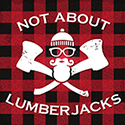
My husband, posing in his new 18th century waistcoat. He’s so silly! As usual, there are more photos at the bottom of this page.
Patterns Used:
– Slight changes to the LACMA “Man’s Waistcoat, France, c. 1750” PDF pattern.
Fabrics Used:
– Gray (blue and peach shot) taffeta (not silk) — same used for my mitts.
– White cotton for lining.
– Some sort of stiff, but thin canvas-like material (I forgot what it was exactly) for interfacing.
Other Materials Used:
– Regular gray and white sewing threads.
– Heavy sewing thread for buttonholes.
– Button cover kits (5/8″ size).
– White embroidery floss for eyelets.
– Twill tape for lacing in the back.
A mixture of machine and hand sewing.
I can’t remember when I first started working on this waistcoat, but I ended up stopping for various reasons. My husband gained a little weight, and I had a few fitting problems due to not having a tape dressform of his shape yet.
I needed something basic, that seemed fancy-ish. One of those types of outfits where he could feel dressed up, but especially once he had more outfits, he wouldn’t mind if it got messed up at an outdoor event.
The pattern itself wasn’t so bad, until I got to the pockets. The pockets are part of the side seam shape, and I had some weird issues with the wide triangle openings not wanting to cooperate. So I sealed them shut by piecing fabrics to the opening. The pocket flaps are tacked down around the edges. It might have been the way I was doing things (I made enough other silly mistakes, so it wouldn’t surprise me)– I’m still somewhat new to sewing or at least do things in my own weird ways, but I think I will stick to slit-opening pockets in the future.
I didn’t make the side lacings, but I did include the back lacing to help with fitting. I’m not sure if I made the skirt shape quite right, but I wanted to keep with a somewhat longish length and flare. I bounce around a little throughout the 18th century (originally the plan was to focus more around the 1740’s), so I don’t stick too closely to specific details since my husband will need to mix-and-match garments until I’m able to finish more things for him.
The gray fabric gave me a little trouble (I also noticed the same thing while embroidering the mitts that used that fabric). Every stitch and pucker really shows up due to the plastic-type feel of the fabric. My husband had picked the fabric out for my mitts, and I knew he loved the color. That’s why I decided to use that fabric for it.
I wanted to make and use more period buttons, but since I was really rushed for time and had a lot of the store-bought covered button kits, these will work for now.
I had a terrible time trying to find proper silk twist thread in a matching color for the buttonholes. I tested different types of threads and embroidery floss and decided that a “Heavy” thread would work best for my needs. With a little light coating of Thread Heaven, and keeping track of the thread as I pulled it through, it gave me the least amount of trouble as well.
I’d been doing some research on buttonholes, and knew I wanted to extend the stitching past the open part of the buttonhole. I adored the look of the wider, shaped buttonhole instead of a thinner stitch. I also needed them to be very sturdy since I wasn’t sure if the waistcoat would fit my husband until he lost weight again. I started off a little too wide, and slowly worked to a little narrower (hoping to keep them all close enough where it wouldn’t stand out too much). I definitely will try to keep them a little narrower if I sew them like this again, and not the usual way I should have done them. With the fabric issues I had, if I look closely at the buttonholes they look a little sloppy. From a regular distance, I actually think they look decent and give a fun look — and my husband absolutely loves them.
Even though I had a lot of troubles and mistakes on this waistcoat, my husband is happy with it and loves it — and it’s one garment more of his that I don’t have to worry about for a while!
Updated 10/16/12: I made another cravat since the original was too long and narrow, and the hems were very wide (this was before I knew how to do rolled hems).
Photos:

My husband had gained a little weight since I first started working on this waistcoat, so there are a few fitting issues, but it works and it’s about time! He’s been waiting for me to finish something for him to wear. He’s wearing jeans under this — his breeches, and jacket were not finished yet.

I didn’t do side lacing, but the back has lacing. I may eventually replace the twill tape with something better.
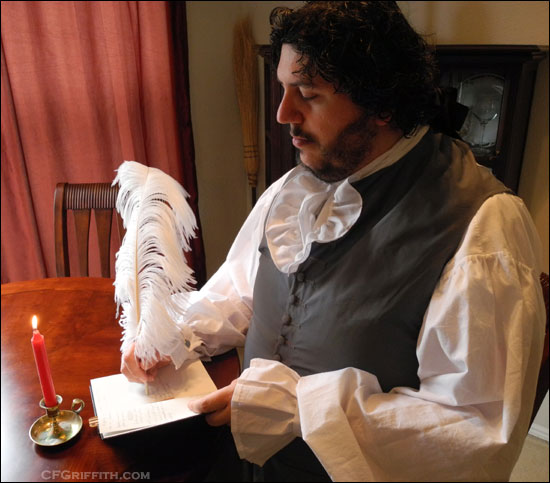
Christopher is a writer, and he’s really never been able to do fun poses in costume — mainly boring old “here, stand like this so I can put this on my blog” photos. I thought this would be fun for him. 🙂
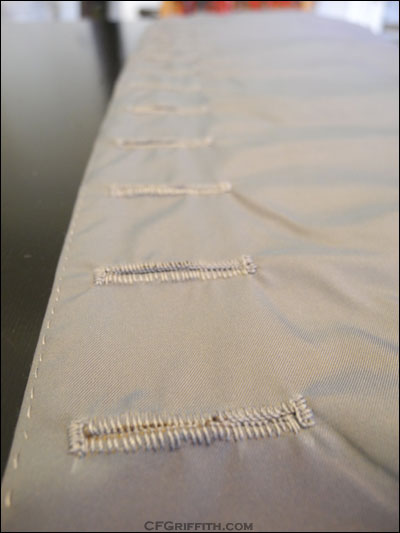
The line of buttonholes. There are 14 buttons and buttonholes.
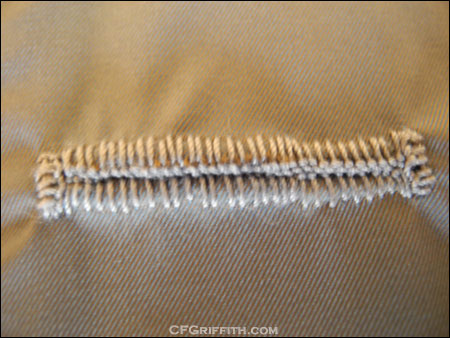
A very closeup shot — I tried my best to keep everything smooth and straight, but this fabric especially shows any mistakes or variances a lot! From a distance, they actually don’t look as bad. Since I couldn’t find the silk twist thread I needed (especially in the color I wanted), I opted for some heavy thread found at most sewing and craft stores. I also wanted to go for a shaped buttonhole for looks (at least from a little distance), as well as a little extra stability and support. Next time, I will do a regular buttonhole line, and if the fabric has a little more give to it (like wool or linen), I’ll also put some cording around the edges.
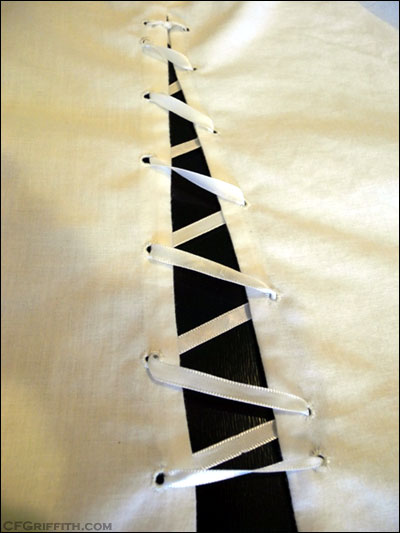
This is the line of lacing holes on the back seam of the waistcoat. This helps with a little better fitting. These are all hand sewn eyelets, and I hope to replace the twill tape with better lacing cord later.
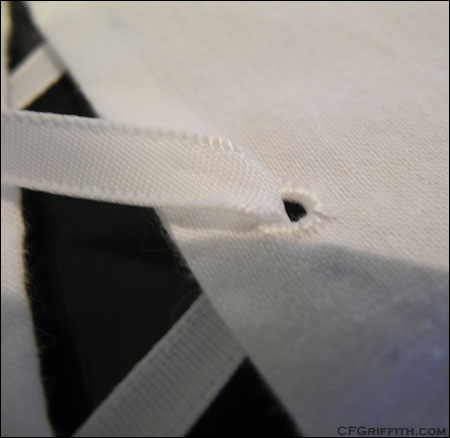
A closeup of one of the back’s hand sewn eyelets.
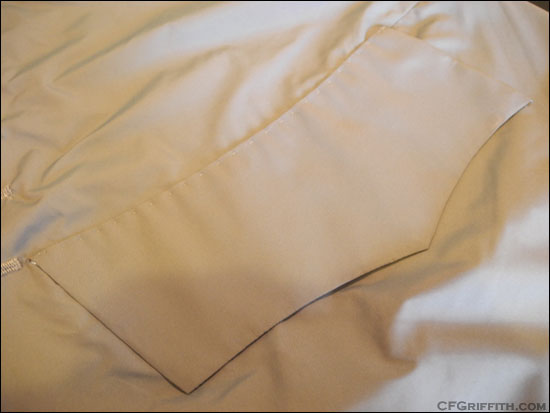
One of the two pocket flaps, covering up the evil triangle-shaped pockets that annoyed me. The pocket holes are sealed shut, and the pocket flap is tacked down on the sides and bottom just enough to keep it from flapping up, but light enough so it doesn’t look like they’re sealed shut.

I made a new cravat since the original was too narrow and the hems were too wide. I’ve been getting more practice with hand sewing rolled hems, so I thought it was a good chance to make another one. I think it will fill in better than the first one.

